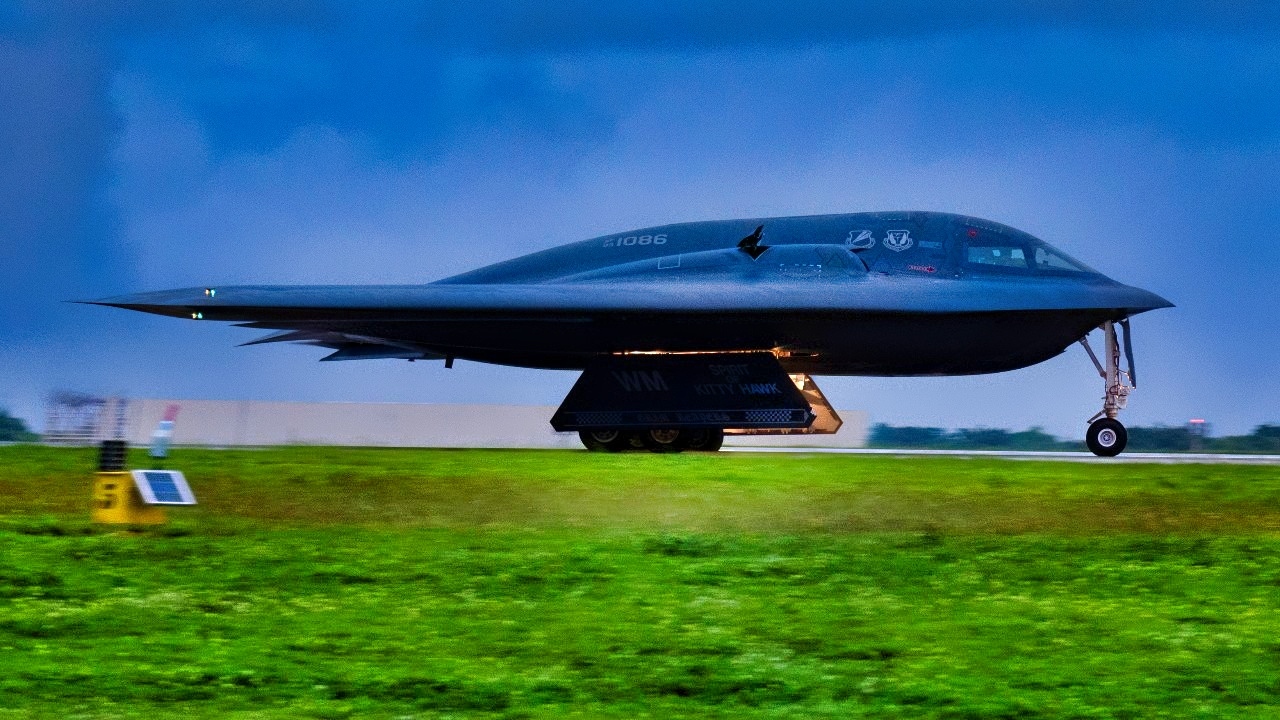B-2 Spirit bombers are in the news again. They are headed for a new deployment in Diego Garcia, an island in the Indian Ocean where the United States could stage massive attacks against the Houthi terrorists in Yemen or even strikes at military and nuclear infrastructure in Iran. The B-2 is one of the best bombers in the Air Force fleet and it can bring death and destruction from its home station at Whiteman Air Force Base in Missouri.
Powerful Missions to Attack Anytime and Anywhere
The B-2s can be armed with nuclear or conventional weapons and they have been a mainstay in the Air Force fleet for decades. These stealth airplanes have a huge combat radius and the ability to hit targets six thousand miles away. They can be aerial re-fueled to extend their range and can be ready in a moment’s notice as a show of force or the instigators of shock and awe attacks.
New Combat Deployment in Central Command
With just a short amount of preparation, the B-2 can strike around the globe and are a good tool for Air Force brass to give military options to the president when tensions are fraught overseas. More than three have already touched down in Diego Garcia over the last 48 hours and these will form a group that will likely punish the Houthis and execute a show of force against Iran.
Death and Destruction from Above
The flying wing design maximizes the bomber’s stealth features. This allows it to evade enemy air defenses and make massive attacks with precision-guided bombs and missiles. With low observability and a massive payload, the B-2 can punish adversaries without the need for boots on the ground.
The airplane uses its stealth characteristics and high altitude to stay out of the range of enemy air defenses. This gives the airplane greater efficacy for targeting and the ability to use its sensors to sniff out enemy surface-to-air missiles and fighter jets.
Combat History Is Impressive
The B-2 was designed during the end of the Cold War under the Reagan administration’s heavy military build-up. It was first publicly shown in Palmdale, California in 1988. The first bomber, nicknamed Spirit of Missouri, was delivered to the Air Force in 1993. There are a total of 20 B-2s today.
The Spirit earned its keep during the war against militants in the former Yugoslavia during Operation Allied Force, the Kosovo Air Campaign, in 1999. The B-2 hammered and blew up 33 percent of all Serbian military sites when flying to Kosovo from Missouri. After 9/11, the B-2 took part in Operation Enduring Freedom for missions against Taliban and al-Qaeda targets in Afghanistan.
B-2s also deployed forward in the Middle East to strike Iraqi targets during Operation Iraqi Freedom. The bombers flew nearly 50 missions from the Central Command Area of Operations and from Whiteman Air Force Base. The B-2s dropped 1.5 million pounds of ordnance on Iraq.
The B-2 is powered by four General Electric F118-GE-100 engines. Each engine has over 17,000 pounds of thrust. The ceiling is 50,000 feet.
B-2 wingspan is 172 feet with an overall length of 69 feet and a height of 17 feet. The maximum take off weight is a gargantuan 336,500 pounds and the payload is 40,000 pounds.
What Pilots Say
The B-2 is pilot friendly and has many fans across the bomber community in the Air Force. 393rd Bomb Squadron commander from Whiteman, Lt. Colonel Joseph “Zorro” Manglitz, is enthusiastic about flying the B-2.
“I would say some of the flight characteristics are generally similar in terms of the speed, altitude employments, things of that nature, I would say the B-2 is more responsive. I kind of say, jokingly, it flies like a Cadillac, it’s very smooth. Anytime we bring folks up in the jet that have not flown it, such as a student for the first time, as soon as you move that stick, the jet responds,” Manglitz told the Aviasionist.
Manglitz was asked if the B-2 flies like a fighter. “Yes, I agree, the cockpit is set up like that. We each have the throttles over on the left side, stick in the middle. The two sides of the cockpit are essentially mirrored and the same, therefore, if we’re flying together and you’re out of the seat taking a nap because of crew fatigue, I can operate the aircraft just fine. The only difference is the there are some switch differences for startup and shutdown,” he said.
The B-2 will someday be replaced by the new B-21 Raider stealth bomber, but until then the Air Force will have a treasure that can fly like a luxury car and respond to controls like a fighter. It has proved its worth in combat and allows the United States chain of command to have immediate options that can strike far-off targets around the world. This gives the Americans a chance to respond rapidly during hot spot contingencies and in wartime. The Spirit will be valuable for years to come until the B-21 arrives in numbers. The Air Force could not be happier with the dominance of the B-2.
About the Author: Dr. Brent M. Eastwood
Brent M. Eastwood, PhD is the author of Don’t Turn Your Back On the World: a Conservative Foreign Policy and Humans, Machines, and Data: Future Trends in Warfare plus two other books. Brent was the founder and CEO of a tech firm that predicted world events using artificial intelligence. He served as a legislative fellow for U.S. Senator Tim Scott and advised the senator on defense and foreign policy issues. He has taught at American University, George Washington University, and George Mason University. Brent is a former U.S. Army Infantry officer. He can be followed on X @BMEastwood.










